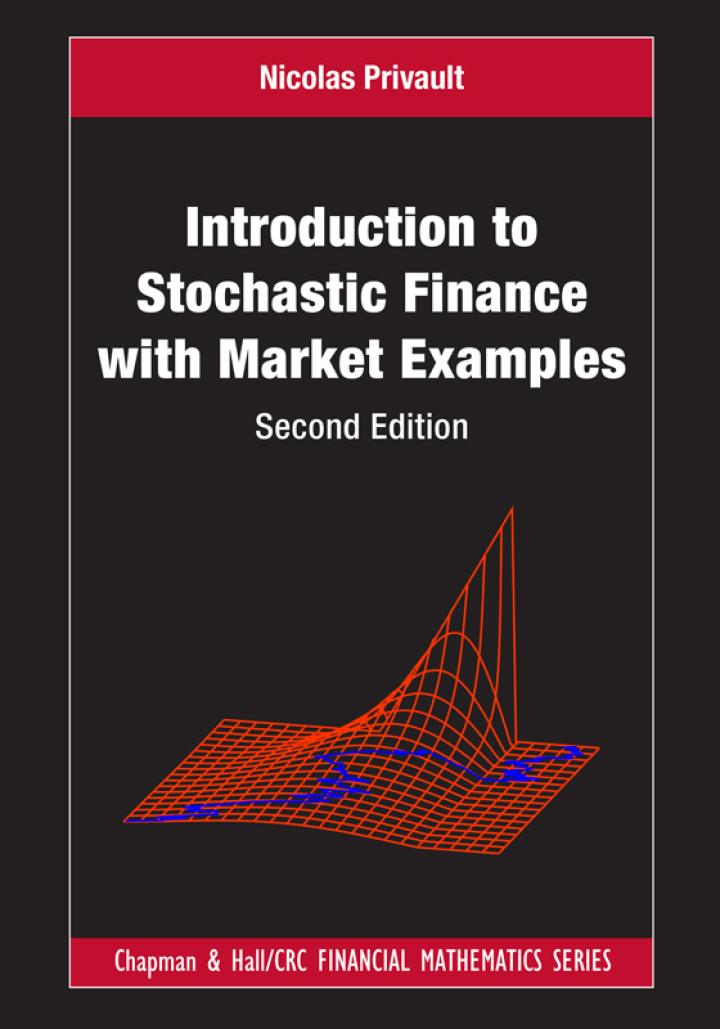Chooser options. In this problem we denote by (Cleft(t, S_{t}, K, Tight)), resp. (Pleft(t, S_{t}, K, Tight)),
Question:
Chooser options. In this problem we denote by \(C\left(t, S_{t}, K, Tight)\), resp. \(P\left(t, S_{t}, K, Tight)\), the price at time \(t\) of the European call, resp. put, option with strike price \(K\) and maturity \(T\), on an underlying asset priced \(S_{t}=S_{0} \mathrm{e}^{\sigma B_{t}+r t-\sigma^{2} t / 2}, t \geqslant 0\), where \(\left(B_{t}ight)_{t \in \mathbb{R}_{+}}\)is a standard Brownian motion under the risk-neutral probability measure
a) Prove the call-put parity formula
\[
\begin{equation*}
C\left(t, S_{t}, K, Tight)-P\left(t, S_{t}, K, Tight)=S_{t}-K \mathrm{e}^{-(T-t) r}, \quad 0 \leqslant t \leqslant T \tag{7.47}
\end{equation*}
\]
b) Consider an option contract with maturity \(T\), which entitles its holder to receive at time \(T\) the value of the European put option with strike price \(K\) and maturity \(U>T\).
Write down the price this contract at time \(t \in[0, T]\) using a conditional expectation under the risk-neutral probability measure \(\mathbb{P}^{*}\).
c) Consider now an option contract with maturity \(T\), which entitles its holder to receive at time \(T\) either the value of a European call option or a European put option, whichever is higher. The European call and put options have same strike price \(K\) and same maturity \(U>T\).
Show that at maturity \(T\), the payoff of this contract can be written as
\[
P\left(T, S_{T}, K, Uight)+\operatorname{Max}\left(0, S_{T}-K \mathrm{e}^{-(U-T) r}ight)
\]
Hint: Use the call-put parity formula (7.47).
d) Price the contract of Question (c) at any time \(t \in[0, T]\) using the call and put option pricing functions \(C(t, x, K, T)\) and \(P(t, x, K, U)\).
e) Using the Black-Scholes formula, compute the self-financing hedging strategy \(\left(\xi_{t}, \eta_{t}ight)_{t \in[0, T]}\) with portfolio value
\[
V_{t}=\xi_{t} S_{t}+\eta_{t} \mathrm{e}^{r t}, \quad 0 \leqslant t \leqslant T
\]
for the option contract of Question (c).
f) Consider now an option contract with maturity \(T\), which entitles its holder to receive at time \(T\) the value of either a European call or a European put option, whichever is lower. The two options have same strike price \(K\) and same maturity \(U>T\).
Show that the payoff of this contract at maturity \(T\) can be written as
\[
C\left(T, S_{T}, K, Uight)-\operatorname{Max}\left(0, S_{T}-K \mathrm{e}^{-(U-T) r}ight)
\]
g) Price the contract of Question (f) at any time \(t \in[0, T]\).
h) Using the Black-Scholes formula, compute the self-financing hedging strategy \(\left(\xi_{t}, \eta_{t}ight)_{t \in[0, T]}\) with portfolio value
\[
V_{t}=\xi_{t} S_{t}+\eta_{t} \mathrm{e}^{r t}, \quad 0 \leqslant t \leqslant T
\]
for the option contract of Question (f).
i) Give the price and hedging strategy of the contract that yields the sum of the payoffs of Questions (c) and (f).
j) What happens when \(U=T\) ? Give the payoffs of the contracts of Questions (c), (f) and (i).
Step by Step Answer:

Introduction To Stochastic Finance With Market Examples
ISBN: 9781032288277
2nd Edition
Authors: Nicolas Privault





